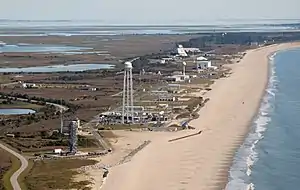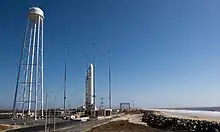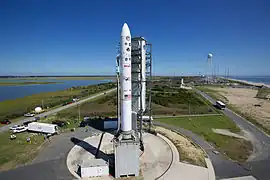Mid-Atlantic Regional Spaceport
The Mid-Atlantic Regional Spaceport (MARS) is a commercial space launch facility located at the southern tip of NASA's Wallops Flight Facility on Wallops Island in Virginia, just east of the Delmarva Peninsula and south of Chincoteague, Virginia, United States. It is owned and operated by the Virginia Spaceport Authority.

| Part of a series on the |
| United States space program |
|---|
  |
Background
The Virginia General Assembly created the political subdivision Virginia Commercial Space Flight Authority (VCSFA), also known as Virginia Space, in 1995 to promote the development of the commercial space flight industry, economic development, aerospace research, and Science, Technology, Engineering, and Math (STEM) education throughout the Commonwealth.[1] This initiative was done from the recommendations of the Batten College at Old Dominion University, with Dr. Billie Reed, a longtime professor at the University, installed as its Executive Director.[2][3][4]
In 1997, Virginia Space entered into a Reimbursable Space Act Agreement with NASA, which provided for permitted use of land on NASA Wallops Island for the MARS launch pads. Virginia Space also applied for and was granted an FAA license to launch to orbit. This led to the establishment of the Virginia Space Flight Center, located on the southern portion of NASA Wallops Island. At the time, the Center served as a collective partnership that included the National Aeronautic and Space Administration (NASA), Old Dominion University, and Virginia Space.[3]
In July 2003, Governors Robert Ehrlich of Maryland and Mark Warner of Virginia signed an agreement that directed the Secretary of Commerce and Trade of Virginia and the Secretary of Business and Economic Development of Maryland to form a working group to develop a concept and implementation plan for joint governance, operation, and administration of the commercial spaceport at Wallops Island.[1] As such, the Virginia Space Flight Center was renamed as the Mid-Atlantic Regional Spaceport (MARS), reflecting the location of the facilities as opposed to the singular state.[2][3]
MARS is approved for launch azimuths from 38° to 60°, making it an ideal location from which to launch to the International Space Station (ISS).[1]
In 2007, NASA selected Virginia-based Orbital Sciences Corporation (Northrop Grumman) to participate in the Commercial Orbital Transportation Services (COTS) program and then selected Orbital for a follow-on Commercial Resupply Service (CRS) contract to build and demonstrate a new rocket, Antares, to resupply the International Space Station (ISS). The CRS contract authorized eight missions from 2012 to 2015 carrying approximately 20,000 kg of cargo to ISS as well as disposal of waste. These launches were to take place from the new state-of-the-art MARS Pad 0A.[1]
On MARS Pad 0B, VCSFA made modifications and upgrades to launch the NASA Lunar Atmosphere and Dust Environment Explorer (LADEE) mission to the Moon in mid-2013 on a new Orbital Sciences Minotaur V launch vehicle. Also in mid-2013, the USAF launched ORS-3 from MARS Pad 0B.[1]
MARS is one of only several sites licensed by the FAA Office of Commercial Space Transportation to launch to orbit. Additionally, Virginia is home to the NASA Langley Research Center (LARC) and National Reconnaissance Office (NRO), and as such is a recipient of a large portion of the Federal budget for Space. Finally, according to the Information Technology and Innovation Foundation, Virginia ranks first in the number of scientists and engineers as a percentage of the workforce, third in the concentration of high-tech jobs as a percentage of the workforce, and sixth in non-industry investment in research and development.[1]
Facilities

The Mid-Atlantic Regional Spaceport has three active orbital launch pads.

Launch Pad 0A (LP-0A)
Pad 0A was built in the 1990s for the Conestoga rocket, which made its only flight in 1995.[5] The launch tower was subsequently demolished in September 2008,[6] and the pad has since been rebuilt for use by the Northrop Grumman Antares.[7] The pad modifications for Antares included the construction of a Horizontal Integration Facility (HIF) for launcher/payload mating and a wheeled transporter/erector that will "roll out and erect the rocket on its launch pad about 24 hours prior to launch".[7]
The facility suffered significant damage during the 28 October 2014 Antares launch failure, according to NASA officials in the immediate aftermath.[8] Preliminary estimates for rebuilding the pad indicated the cost should be no more than US$20 million.[9] By May 2015, that estimate had been revised down to US$13 million and repairs were expected to be completed by September or October 2015 with the next planned launch in March 2016.[10] On September 30, 2015, the spaceport announced repairs on pad 0A had been completed.[11]
Following the Cygnus NG-19 launch in August 2023, Pad 0A was taken offline for the pad and facilities to be upgraded to support the new Antares 330 rocket, which will have approximately twice the thrust as its predecessor, Antares 230+. The pad and transporter erector must accept the wider diameter of the new first stage, and the HIF must be lengthened. In addition, the complex is being upgraded to support the future Northrop Grumman Medium Launch Vehicle, based off Antares 330 but sporting a liquid-fueled second stage.[12]
Pad 0A is located at 37.833959°N 75.4878331°W.
Launch Pad 0B (LP-0B)
Pad 0B became operational in 1999,[13] and was subsequently upgraded with the construction of a mobile service tower, which was completed in 2004.[14] It remains active, and is currently used by Northrop Grumman Minotaur rockets. However, the Minotaur launch rate has decreased in recent years, leaving multi-year gaps between launches from Pad 0B.
Pad 0B hosted the Minotaur V launch of the LADEE lunar orbiter in 2013, becoming the first (and so far only) beyond-Earth mission to launch from Wallops.
Pad 0B is located at 37.8311576°N 75.4913829°W
Launch Complex-2 (LC-2)/Launch Pad 0C (LP-0C)
In October 2018, Rocket Lab announced that it had selected MARS as its second launch site, called Rocket Lab Launch Complex-2. The company began construction in February 2019, together with the Virginia Commercial Space Flight Authority (Virginia Space). In December 2019, Rocket Lab said it had built and completed Launch Complex-2 (LC-2) (located at 37.833266°N 75.4882304°W),[15] a new launch pad near Pad 0A, and was ready to support missions just 10 months later with the first launch scheduled for the third quarter of 2020.[16] At a press conference on the same day at the NASA Wallops Flight Facility, the Space Test Program of the United States Air Force (now United States Space Force) was announced as the planned first customer for the Electron launch vehicle from LC-2. The mission was planned to see a single research and development micro-satellite. This plan did not occur.[17]
The new launch complex LC-2 also has an offsite integration facility.[18]
The first launch from LC-2 successfully occurred on January 24, 2023. An Electron rocket carried three satellites to orbit in a mission named "Virginia is for Launch Lovers", the launch title referencing Virginia's well-known tourism slogan "Virginia is for Lovers".[19][20]
Launch history
| Launch | Date (UTC) | Vehicle | Payload | Launch pad | Result | Remarks |
|---|---|---|---|---|---|---|
| 1 | 23 October 1995, 22:02 | Conestoga 1620 | Meteor recoverable experimental satellite | Pad 0A | Failure | The only orbital launch attempt of Conestoga. |
| 2 | 16 December 2006, 12:00 | Minotaur I | TacSat-2 / GeneSat-1 | Pad 0B | Success[21] | |
| 3 | 24 April 2007, 06:48 | Minotaur I | NFIRE | Pad 0B | Success[21] | |
| 4 | 22 August 2008, 09:10 | ALV X-1 | Hy-BoLT / SOAREX-VI | Pad 0B | Failure[22] | Suborbital launch. |
| 5 | 19 May 2009, 23:55 | Minotaur I | TacSat-3 | Pad 0B | Success | |
| 6 | 30 June 2011, 03:09 | Minotaur I | USAF ORS-1 Satellite | Pad 0B | Success | |
| 7 | 21 April 2013, 21:00 | Antares 110 | Cygnus Mass Simulator | Pad 0A | Success[23] | |
| 8 | 7 September 2013, 03:27 | Minotaur V | LADEE mission to Lunar orbit | Pad 0B | Success | |
| 9 | 18 September 2013, 14:58 | Antares 110 | Cygnus Orb-D1 COTS Demo Mission | Pad 0A | Success[24] | |
| 10 | 20 November 2013, 01:15 | Minotaur I | ORS 3, STPSat-3 | Pad 0B | Success | |
| 11 | 9 January 2014, 18:07[25][26][27] | Antares 120 | Cygnus CRS Orb-1 | Pad 0A | Success | First Cygnus. ISS re-supply mission. |
| 12 | 13 July 2014, 16:52[28] | Antares 120 | Cygnus CRS Orb-2 | Pad 0A | Success | ISS re-supply mission. |
| 13 | 28 October 2014, 22:22[29] | Antares 130 | Cygnus CRS Orb-3 | Pad 0A | Failure[30] | Pad damaged by explosion and fire. |
| 14 | 17 October 2016, 23:45 [31] | Antares 230 | Cygnus CRS OA-5 | Pad 0A (rebuilt) | Success | ISS re-supply mission. |
| 15 | 12 November 2017, 12:19 | Antares 230 | Cygnus CRS OA-8E | Pad 0A | Success | ISS re-supply mission. |
| 16 | 21 May 2018, 08:44 | Antares 230 | Cygnus CRS OA-9E | Pad 0A | Success | ISS re-supply mission. |
| 17 | 17 November 2018, 09:01 | Antares 230 | Cygnus NG-10 | Pad 0A | Success | ISS re-supply mission. |
| 18 | 17 April 2019, 16:46 | Antares 230 | Cygnus NG-11 | Pad 0A | Success | ISS re-supply mission. |
| 19 | 2 November 2019, 13:59 | Antares 230+ | Cygnus NG-12 | Pad 0A | Success | ISS re-supply mission. |
| 20 | 15 February 2020, 20:21 | Antares 230+ | Cygnus NG-13 | Pad 0A | Success | ISS re-supply mission. |
| 21 | 15 July 2020, 13:46 [32] | Minotaur IV | NROL-129 | Pad 0B | Success | Classified NRO payload. |
| 22 | 3 October 2020, 02:16 | Antares 230+ | Cygnus NG-14 | Pad 0A | Success | ISS re-supply mission. |
| 23 | 20 February 2021, 17:36 | Antares 230+ | Cygnus NG-15 | Pad 0A | Success | ISS re-supply mission. |
| 24 | 15 June 2021, 13:35 | Minotaur I | NROL-111 | Pad 0B | Success | Classified NRO payload. |
| 25 | 10 August 2021, 22:01 | Antares 230+ | Cygnus NG-16 | Pad 0A | Success | ISS re-supply mission. |
| 26 | 19 February 2022, 17:40 | Antares 230+ | Cygnus NG-17 | Pad 0A | Success | ISS re-supply mission. |
| 27 | 7 November 2022, 10:32 | Antares 230+ | Cygnus NG-18 | Pad 0A | Success | ISS re-supply mission. |
| 28 | 24 January 2023, 23:00 | Electron | HawkEye 360 Cluster 6 | LC-2 | Success | First launch from Rocket Lab Launch Complex-2.[33] |
| 29 | 16 March 2023, 22:39 | Electron | Capella 9, 10 | LC-2 | Success | |
| 30 | 18 June 2023, 01:25 | Electron | HASTE: DYNAMO-A | LC-2 | Success[34] | First launch of the HASTE program; suborbital trajectory |
| 31 | 2 August 2023, 00:31 | Antares 230+ | Cygnus NG-19 | Pad 0A | Success | ISS re-supply mission. Final launch of Antares 200 Series |
References
- "History of MARS". www.vaspace.org. Retrieved 28 October 2020.
- "Space: The Final Frontier Starts at Wallops Island". www.virginiaplaces.org. Retrieved 2022-07-20.
- "Virginia Space Flight Center". 2003-02-07. Archived from the original on 7 February 2003. Retrieved 2022-07-20.
- "Director and Personnel of the Virginia Space Flight Center at the Wallops Flight Facility". 2003-02-07. Archived from the original on 7 February 2003. Retrieved 2022-07-20.
- Wade, Mark. "Wallops Island LA0A". Encyclopedia Astronautica. Archived from the original on 2008-11-20. Retrieved 2009-01-21.
- "Launch Tower Demolition". GMB. Archived from the original on 2009-02-21. Retrieved 2009-01-21.
- Kyle, Ed (2011-05-14). "Taurus 2". Space Launch Report. Retrieved 2011-12-19.
- Botelho, Gerg. "Unmanned NASA-contracted rocket explodes; damage was 'significant'". CNN. Retrieved 2014-10-28.
- Foust, Jeff (2014-11-21). "Virginia May Seek Federal Funds for Wallops Spaceport Repairs". Space News. Archived from the original on December 1, 2014. Retrieved 2014-12-01.
- Leone, Dan (May 15, 2015). "With $2 Million Left on Wallops Repair Bill, NASA and Virginia Look to Orbital ATK To Dig Deeper". Space News. Retrieved July 19, 2015.
- "Completion Of Repairs at the Mid-Atlantic Regional Spaceport Launch Pad 0A". vaspace.org. September 30, 2015.
- Davenport, Justin. "Northrop Grumman and Firefly's Antares 330 and MLV plans take shape". NASASpaceflight.com. NASASpaceflight. Retrieved 12 September 2023.
- "Facilities". Mid-Atlantic Regional Spaceport. Archived from the original on October 16, 2008. Retrieved 2009-01-21.
- "Launch Pad 0-B" (PDF). Mid-Atlantic Regional Spaceport. Archived from the original (PDF) on July 4, 2008. Retrieved 2009-01-21.
- Powers, Kelly (17 December 2019). "Launch platform marks milestone". The Daily Times. Salisbury, Maryland. Archived from the original on 18 April 2022. Retrieved 18 April 2022 – via Newspapers.com.
- "Rocket Lab tests Electron on new Virginia launch pad". SpaceNews.com. 2020-04-30. Retrieved 2020-05-24.
- "Updates". Rocket Lab. Retrieved 28 October 2020.
- "Rocket Lab | Our Launch Sites". Rocket Lab. Retrieved 2018-12-30.
- "Rocket Lab conducts first Electron launch from American soil". NASASpaceflight. Retrieved 2023-01-24.
- Harwood, William (2023-01-24). "Rocket Lab launches 3 satellites in first mission from U.S. soil". CBS News. Retrieved 2023-01-25.
- Wade, Mark. "Wallops Island LA0B". Encyclopedia Astronautica. Archived from the original on 2011-11-15. Retrieved 2011-12-19.
- Tennant, Diane (22 Aug 2008). "NASA destroys rocket shortly after launch at Wallops Island". Virginian-Pilot. Retrieved 2 November 2014.
- "Antares Maiden Soar Pierces Virginia Sky and delivers NASA SmartPhone Pioneer Nanosats to Orbit - Universe Today". 24 April 2013. Retrieved 12 September 2018.
- Dietrich, Tamara (19 September 2013). "Cargo ship takes off for station". Daily Press. Newport News, Virginia. p. A4. Archived from the original on 18 April 2022. Retrieved 18 April 2022 – via Newspapers.com.
- "ORB-1: Antares successfully launches Cygnus en route to ISS – NASASpaceFlight.com". www.nasaspaceflight.com. Retrieved 12 September 2018.
- "Northrop Grumman Corporation". Northrop Grumman. Retrieved 12 September 2018.
- "NASA - NSSDCA - Spacecraft - Details". nssdc.gsfc.nasa.gov. Retrieved 28 October 2020.
- Beutel, Allard (3 April 2015). "NASA Cargo Launches to Station Aboard Orbital Resupply Mission". Retrieved 12 September 2018.
- "Antares Launch Postponed to Oct. 28 – Orbital ATK". blogs.nasa.gov. Archived from the original on 25 April 2015. Retrieved 12 September 2018.
- "Teams investigate failure of unmanned rocket off Virginia coast". CNN.
- Beutel, Allard (17 October 2016). "Orbital ATK Launches NASA Resupply Mission to Space Station". Retrieved 12 September 2018.
- Koehler, Keith (15 July 2020). "Minotaur IV Launches from Wallops". Archived from the original on 18 April 2022. Retrieved 15 July 2020.
- Harwood, William (2023-01-24). "Rocket Lab launches 3 satellites in first mission from U.S. soil". CBS News. Retrieved 2023-01-25.
- "Rocket Lab Debuts HASTE Rocket with First Successful Suborbital Launch from Virginia". Rocket Lab. Rocket Lab. Retrieved 24 October 2023.